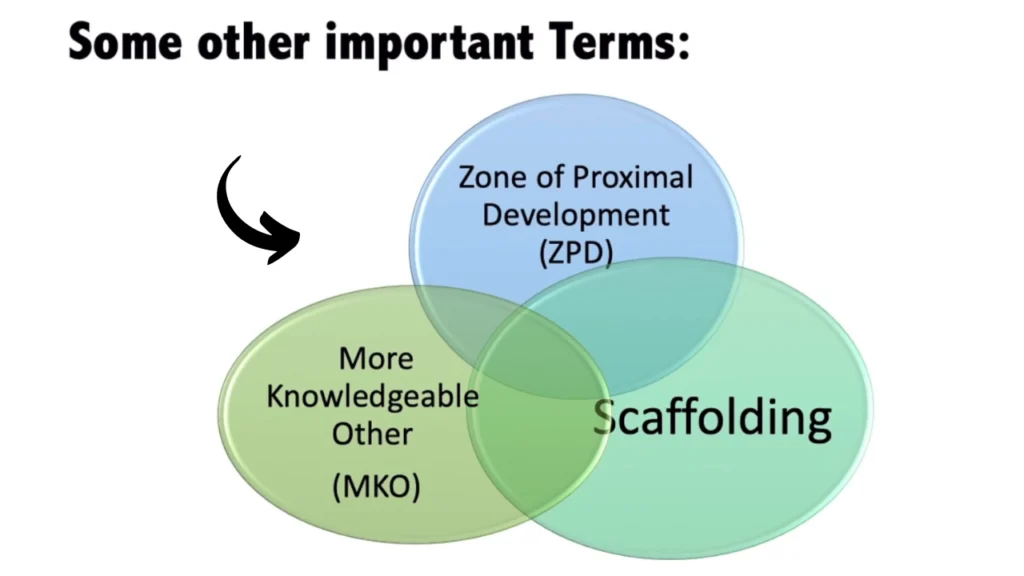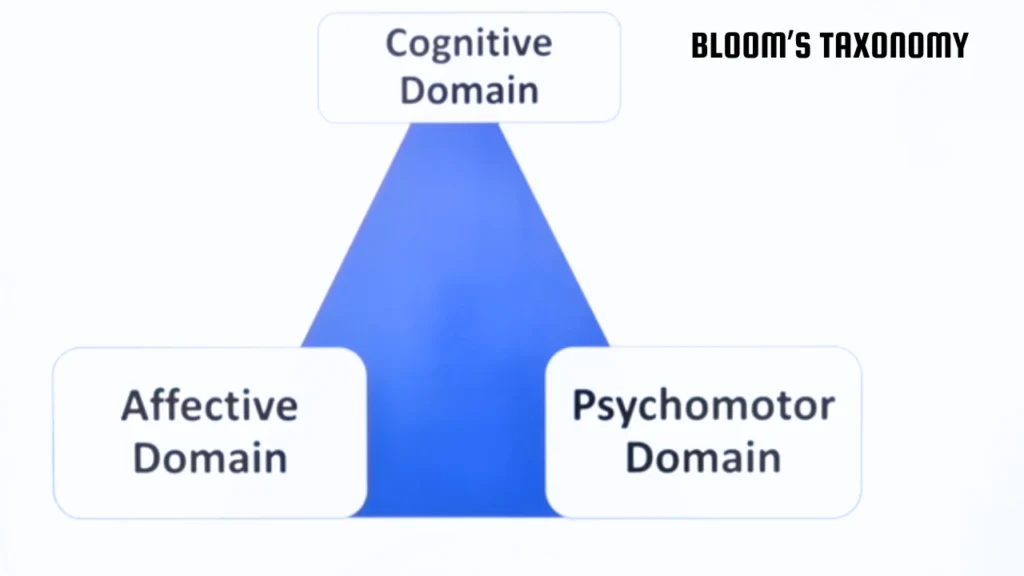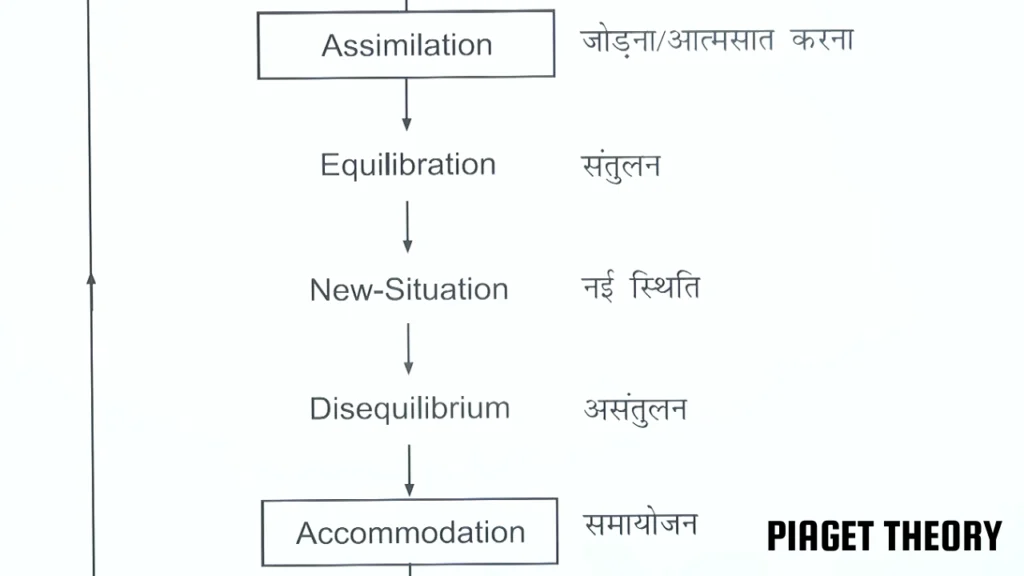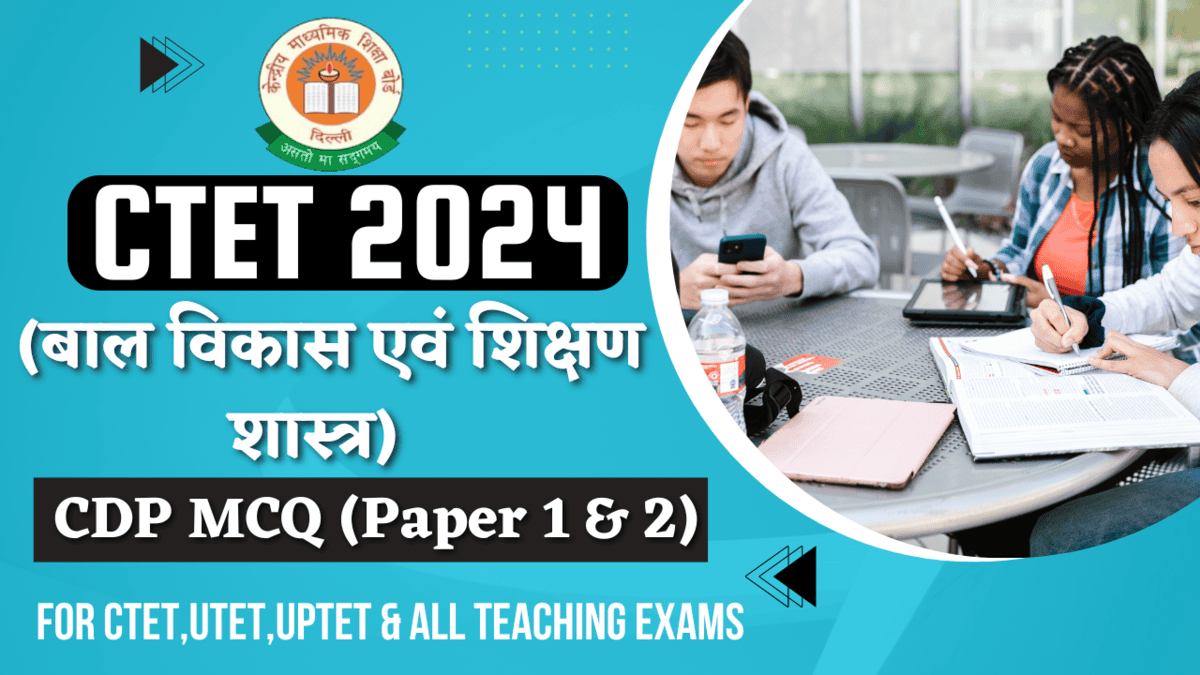Ctet CDP MCQ in Hindi : केंद्रीय माध्यमिक शिक्षक बोर्ड CTET जुलाई माह में अध्यापक पात्रता परीक्षा CTET 2024 आयोजित करने जा रहा है । जिन भी अभ्यर्थियों ने CTET 2024 की परीक्षा के लिए आवेदन किया है, वह अपनी परीक्षा की तैयारी जल्दी ही शुरू कर दें । परीक्षा की तैयारी को मजबूत करने के लिए आज हम आपके लिए बाल विकास एवं शिक्षण शास्त्र के महत्वपूर्ण प्रश्नों (CTET CDP MCQ in Hindi) को लेकर आए हैं, इन प्रश्नों के माध्यम से आप बाल विकास एवं शिक्षण शास्त्र से जुड़े महत्वपूर्ण प्रश्नों को हल कर पाएंगे ।
बाल विकास एवं शिक्षण शास्त्र के प्रश्न सभी शिक्षक पात्रता परीक्षा CTET,UPTET,UTET,HTET, MPTET आदि में पूछे जाते हैं । यदि आप भी शिक्षक भर्ती परीक्षा की तैयारी कर रहे हैं तो आपके लिए यह बाल विकास एवं शिक्षण शास्त्र के प्रश्न (CTET CDP MCQ in Hindi) बहुत ही उपयोगी होंगे । परीक्षा में जाने से पहले बाल विकास एवं शिक्षण शास्त्र के महत्वपूर्ण प्रश्न उत्तर हिंदी में को एक बार जरूर पढ़ें ।
CTET CDP MCQ in Hindi | CDP Notes in Hindi | CTET CDP Important MCQ | CTET CDP One Liner | CTET 2024 CDP MCQ
Q1. Which of the following best describes Piaget’s theory of cognitive development?
A) Children learn best through rote memorization
B) Cognitive development occurs in distinct stages
C) Learning is a continuous and smooth process
D) Social interaction is the primary driver of cognitive development
Answer: B) Cognitive development occurs in distinct stages
Q1. निम्नलिखित में से कौन पियाजे के संज्ञानात्मक विकास के सिद्धांत का सबसे अच्छा वर्णन करता है?
a) बच्चे रटकर याद करने से सबसे अच्छा सीखते हैं
b) संज्ञानात्मक विकास अलग-अलग चरणों में होता है
c) सीखना एक सतत और सुचारू प्रक्रिया है
d) सामाजिक संपर्क संज्ञानात्मक विकास का प्राथमिक चालक है
उत्तर: b) संज्ञानात्मक विकास अलग-अलग चरणों में होता है
Q2. Erik Erikson’s theory of psychosocial development includes how many stages?
A) 4
B) 5
C) 6
D) 8
Answer: D) 8
Q2. एरिक एरिकसन के मनोसामाजिक विकास के सिद्धांत में कितने चरण शामिल हैं?
a) 4
b) 5
c) 6
d) 8
उत्तर: d) 8
Q3. According to Kohlberg, which stage of moral development is characterized by a child’s understanding of societal rules and laws?
A) Pre-conventional
B) Conventional
C) Post-conventional
D) Autonomous
Answer: B) Conventional
Q3. कोहलबर्ग के अनुसार, नैतिक विकास के किस चरण में बच्चे को सामाजिक नियमों और कानूनों की समझ होती है?
a) पूर्व-पारंपरिक
b) पारंपरिक
c) उत्तर-परंपरागत
d) स्वायत्त
उत्तर: b) पारंपरिक
Q4. Which of the following is a key principle of constructivist teaching?
A) Learning occurs passively through absorption of information
B) Students learn best through memorization and repetition
C) Knowledge is actively constructed by learners through interaction with their environment
D) Teachers should provide all the information for students to memorize
Answer: C) Knowledge is actively constructed by learners through interaction with their environment
Q4. निम्नलिखित में से कौन सा रचनावादी शिक्षण का प्रमुख सिद्धांत है?
a) सूचना के अवशोषण के माध्यम से सीखना निष्क्रिय रूप से होता है
b) छात्र याद रखने और दोहराने के माध्यम से सबसे अच्छा सीखते हैं
c) ज्ञान का निर्माण शिक्षार्थियों द्वारा अपने पर्यावरण के साथ बातचीत के माध्यम से सक्रिय रूप से किया जाता है
d) शिक्षकों को छात्रों को याद रखने के लिए सभी जानकारी प्रदान करनी चाहिए
उत्तर: c) ज्ञान का निर्माण शिक्षार्थियों द्वारा अपने पर्यावरण के साथ बातचीत के माध्यम से सक्रिय रूप से किया जाता है
Q5. What is the primary goal of formative assessment in the classroom?
A) To assign grades to students
B) To compare students’ performance with each other
C) To monitor student learning and provide ongoing feedback
D) To determine the final level of student achievement
Answer: C) To monitor student learning and provide ongoing feedback
Q5. कक्षा में रचनात्मक मूल्यांकन का प्राथमिक लक्ष्य क्या है?
a) छात्रों को ग्रेड आवंटित करना
b) छात्रों के प्रदर्शन की एक दूसरे से तुलना करना
c) छात्रों के सीखने की निगरानी करना और निरंतर फीडबैक प्रदान करना
d) छात्र उपलब्धि के अंतिम स्तर को निर्धारित करने के लिए
उत्तर: c) छात्रों के सीखने की निगरानी करना और निरंतर फीडबैक प्रदान करना
Q6. Which of the following best describes the term “scaffolding” in educational psychology?
A) Providing external rewards to motivate students
B) Gradually withdrawing support as students become more proficient
C) Punishing students to discourage incorrect behavior
D) Structuring classroom activities to maintain order
Answer: B) Gradually withdrawing support as students become more proficient

Q6. निम्नलिखित में से कौन शैक्षिक मनोविज्ञान में “मचान” शब्द का सबसे अच्छा वर्णन करता है?
a) छात्रों को प्रेरित करने के लिए बाहरी पुरस्कार प्रदान करना
b) जैसे-जैसे छात्र अधिक कुशल होते जाते हैं, धीरे-धीरे समर्थन वापस लेना
c) गलत व्यवहार को हतोत्साहित करने के लिए छात्रों को दंडित करना
d) व्यवस्था बनाए रखने के लिए कक्षा की गतिविधियों की संरचना करना
उत्तर: b) जैसे-जैसे छात्र अधिक कुशल होते जाते हैं, धीरे-धीरे समर्थन वापस लेना
Read More – CTET CDP MCQ in Hindi | बाल विकास एवं शिक्षण शास्त्र के महत्वपूर्ण प्रश्न उत्तर
Q7. Which of the following approaches is most effective for promoting social and emotional development in young children?
A) Focusing solely on academic skills
B) Encouraging competition among peers
C) Creating a supportive and nurturing classroom environment
D) Limiting social interactions to prevent conflicts
Answer: C) Creating a supportive and nurturing classroom environment
Q7. छोटे बच्चों में सामाजिक और भावनात्मक विकास को बढ़ावा देने के लिए निम्नलिखित में से कौन सा दृष्टिकोण सबसे प्रभावी है?
A) केवल शैक्षणिक कौशल पर ध्यान केंद्रित करना
B) साथियों के बीच प्रतिस्पर्धा को प्रोत्साहित करना
C) एक सहायक और पोषित कक्षा वातावरण बनाना
D) संघर्षों को रोकने के लिए सामाजिक मेलजोल को सीमित करना
उत्तर: C) एक सहायक और पोषित कक्षा वातावरण बनाना
Q8. What is the primary purpose of using play-based learning in early childhood education?
A) To keep children entertained
B) To develop social and cognitive skills through structured activities
C) To reduce the amount of instructional time needed
D) To prepare children for standardized testing
Answer: B) To develop social and cognitive skills through structured activities
Q8. प्रारंभिक बचपन की शिक्षा में खेल-आधारित शिक्षा का उपयोग करने का प्राथमिक उद्देश्य क्या है?
A) बच्चों का मनोरंजन करने के लिए
B) संरचित गतिविधियों के माध्यम से सामाजिक और संज्ञानात्मक कौशल विकसित करना
C) आवश्यक शिक्षण समय की मात्रा को कम करने के लिए
D) बच्चों को मानकीकृत परीक्षण के लिए तैयार करना
उत्तर: B) संरचित गतिविधियों के माध्यम से सामाजिक और संज्ञानात्मक कौशल विकसित करना
Q9. Which of the following best describes the concept of “inclusive education”?
A) Providing education to students with special needs in separate classrooms
B) Integrating all students, regardless of their abilities, into mainstream classrooms
C) Focusing only on the needs of gifted students
D) Teaching students with disabilities only in specialized schools
Answer: B) Integrating all students, regardless of their abilities, into mainstream classrooms
Q9. निम्नलिखित में से कौन सा “समावेशी शिक्षा” की अवधारणा का सबसे अच्छा वर्णन करता है?
A) विशेष आवश्यकता वाले छात्रों को अलग कक्षाओं में शिक्षा प्रदान करना
B) सभी छात्रों को, उनकी क्षमताओं की परवाह किए बिना, मुख्यधारा की कक्षाओं में एकीकृत करना
C) केवल प्रतिभाशाली छात्रों की जरूरतों पर ध्यान केंद्रित करना
D) विकलांग छात्रों को केवल विशेष स्कूलों में पढ़ाना
उत्तर: बी) सभी छात्रों को, उनकी क्षमताओं की परवाह किए बिना, मुख्यधारा की कक्षाओं में एकीकृत करना
Q10. Which of the following practices is recommended for fostering a positive learning environment?
A) Maintaining strict discipline with no room for flexibility
B) Encouraging student participation and collaboration
C) Using fear of punishment to motivate students
D) Focusing solely on academic performance
Answer: B) Encouraging student participation and collaboration
Q10. सकारात्मक शिक्षण वातावरण को बढ़ावा देने के लिए निम्नलिखित में से कौन सी प्रथा अनुशंसित है?
A) लचीलेपन के लिए कोई जगह न रखते हुए सख्त अनुशासन बनाए रखना
B) छात्र भागीदारी और सहयोग को प्रोत्साहित करना
C) छात्रों को प्रेरित करने के लिए सजा के डर का उपयोग करना
D) केवल शैक्षणिक प्रदर्शन पर ध्यान केंद्रित करना
उत्तर: B) छात्र भागीदारी और सहयोग को प्रोत्साहित करना
Q11. According to Jerome Bruner, which mode of representation is the first to develop in children?
A) Symbolic
B) Enactive
C) Iconic
D) Abstract
Answer: B) Enactive
Q11. जेरोम ब्रूनर के अनुसार, बच्चों में सबसे पहले प्रतिनिधित्व का कौन सा तरीका विकसित होता है?
A) प्रतीकात्मक
B) सक्रिय
C) प्रतिष्ठित
D) सार
उत्तर: B) सक्रिय
Q12. What is the primary focus of child-centered pedagogy?
A) Teacher-directed instruction
B) Focusing on memorization and repetition
C) Encouraging active participation and exploration by the child
D) Ensuring students perform well on standardized tests
Answer: C) Encouraging active participation and exploration by the child
Q12. बाल-केन्द्रित शिक्षाशास्त्र का प्राथमिक फोकस क्या है?
A) शिक्षक-निर्देशित निर्देश
B) याद रखने और दोहराने पर ध्यान केंद्रित करना
C) बच्चे की सक्रिय भागीदारी और अन्वेषण को प्रोत्साहित करना
D) यह सुनिश्चित करना कि छात्र मानकीकृत परीक्षणों में अच्छा प्रदर्शन करें
उत्तर: C) बच्चे की सक्रिय भागीदारी और अन्वेषण को प्रोत्साहित करना
Q13. Which of the following is an example of intrinsic motivation in students?
A) Studying to get good grades
B) Completing assignments to avoid punishment
C) Learning a new topic because of genuine interest
D) Participating in a competition to win a prize
Answer: C) Learning a new topic because of genuine interest
Q14. In Bloom’s Taxonomy, which of the following is the highest level of cognitive skills?
A) Understanding
B) Applying
C) Analyzing
D) Creating
Answer: D) Creating

Q14. ब्लूम के वर्गीकरण में, निम्नलिखित में से कौन सा संज्ञानात्मक कौशल का उच्चतम स्तर है?
A) समझ
B) आवेदन करना
C) विश्लेषण करना
D) बनाना
उत्तर: D) बनाना
Q15. Which of the following is a characteristic of an effective classroom management strategy?
A) Ignoring disruptive behavior
B) Consistently applying rules and procedures
C) Using frequent punishments to control behavior
D) Allowing students to create their own rules without guidance
Answer: B) Consistently applying rules and procedures
Q15. निम्नलिखित में से कौन एक प्रभावी कक्षा प्रबंधन रणनीति की विशेषता है?
A) विघटनकारी व्यवहार को नजरअंदाज करना
B) नियमों और प्रक्रियाओं को लगातार लागू करना
C) व्यवहार को नियंत्रित करने के लिए बार-बार दंड देना
D) छात्रों को मार्गदर्शन के बिना अपने स्वयं के नियम बनाने की अनुमति देना
उत्तर: B) नियमों और प्रक्रियाओं को लगातार लागू करना
Q16. According to Jean Piaget, which stage of cognitive development is characterized by the ability to think logically about abstract propositions and test hypotheses systematically?
A) Sensorimotor
B) Preoperational
C) Concrete Operational
D) Formal Operational
Answer: D) Formal Operational

Q16. जीन पियागेट के अनुसार, संज्ञानात्मक विकास के किस चरण में अमूर्त प्रस्तावों के बारे में तार्किक रूप से सोचने और व्यवस्थित रूप से परिकल्पनाओं का परीक्षण करने की क्षमता होती है?
A) सेंसरिमोटर
B) प्रीऑपरेशनल
C) ठोस परिचालन
D) औपचारिक परिचालन
उत्तर: D) औपचारिक परिचालन
Q17. Which of the following is an effective strategy to support students with learning disabilities?
A) Lowering academic expectations
B) Providing individualized instruction and support
C) Ignoring their specific needs to promote independence
D) Separating them from their peers in a different classroom
Answer: B) Providing individualized instruction and support
Q17. सीखने की अक्षमता वाले छात्रों का समर्थन करने के लिए निम्नलिखित में से कौन सी एक प्रभावी रणनीति है?
A) शैक्षणिक अपेक्षाओं को कम करना
B) व्यक्तिगत निर्देश और सहायता प्रदान करना
C) स्वतंत्रता को बढ़ावा देने के लिए उनकी विशिष्ट आवश्यकताओं की अनदेखी करना
D) उन्हें अलग कक्षा में उनके साथियों से अलग करना
उत्तर: B) व्यक्तिगत निर्देश और सहायता प्रदान करना
Q18. What does the term “scaffolding” refer to in the context of education?
A) Gradual reduction of teacher support as students become more competent
B) Providing the answers to students directly
C) Setting high expectations without guidance
D) Punishing students for incorrect answers
Answer: A) Gradual reduction of teacher support as students become more competent
Q18. शिक्षा के संदर्भ में “मचान” शब्द का क्या अर्थ है?
A) जैसे-जैसे छात्र अधिक सक्षम होते जाते हैं शिक्षक समर्थन में धीरे-धीरे कमी आती जाती है
B) छात्रों को सीधे उत्तर प्रदान करना
C) मार्गदर्शन के बिना उच्च उम्मीदें स्थापित करना
D) गलत उत्तरों के लिए छात्रों को दंडित करना
उत्तर: A) जैसे-जैसे छात्र अधिक सक्षम होते जाते हैं, शिक्षक सहायता में धीरे-धीरे कमी आती जाती है
Q19. Which learning theory emphasizes the importance of observational learning, imitation, and modeling?
A) Behaviorism
B) Constructivism
C) Social Learning Theory
D) Cognitive Development Theory
Answer: C) Social Learning Theory
Q19. कौन सा शिक्षण सिद्धांत अवलोकनात्मक शिक्षा, अनुकरण और मॉडलिंग के महत्व पर जोर देता है?
A) व्यवहारवाद
B) रचनावाद
C) सामाजिक शिक्षण सिद्धांत
D) संज्ञानात्मक विकास सिद्धांत
उत्तर: C) सामाजिक शिक्षण सिद्धांत
Q20. Which of the following is a characteristic of formative assessment?
A) It is used primarily for grading purposes
B) It occurs at the end of an instructional period
C) It provides ongoing feedback to improve student learning
D) It is standardized and summative
Answer: C) It provides ongoing feedback to improve student learning
Q20. निम्नलिखित में से कौन-सी रचनात्मक मूल्यांकन की विशेषता है?
A) इसका उपयोग मुख्य रूप से ग्रेडिंग उद्देश्यों के लिए किया जाता है
B) यह एक शिक्षण अवधि के अंत में होता है
C) यह छात्रों के सीखने को बेहतर बनाने के लिए निरंतर फीडबैक प्रदान करता है
D) यह मानकीकृत और योगात्मक है
उत्तर: C) यह छात्रों के सीखने में सुधार के लिए निरंतर फीडबैक प्रदान करता है
